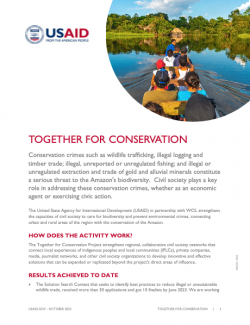Conservation crimes such as wildlife trafficking, illegal logging and timber trade; illegal, unreported or unregulated fishing; and illegal or unregulated extraction and trade of gold and alluvial minerals constitute a serious threat to the Amazon's biodiversity. Civil society plays a key role in addressing these conservation crimes, whether as an economic agent or exercising civic action.
The United State Agency for International Development (USAID) in partnership with WCS, strengthens the capacities of civil society to care for biodiversity and prevent environmental crimes, connecting urban and rural areas of the region with the conservation of the Amazon.
HOW DOES THE PROJECT WORK?
The Together for Conservation Project strengthens regional, collaborative civil society networks that connect local experiences of indigenous peoples and local communities (IPLCs), private companies, media, journalist networks, and other civil society organizations to develop innovative and effective solutions that can be expanded or replicated beyond the project's direct areas of influence.
RESULTS ACHIEVED TO DATE
- The Solution Search Contest that seeks to identify best practices to reduce illegal or unsustainable wildlife trade, received more than 30 applications and got 10 finalists by June 2023. We are working collaboratively with them to develop and disseminate a toolkit to apply behavioral change sciences to address this challenge.
- The Project is supporting the involvement of IPLCs and private partners in sustainable value chains with a gender focus, for example:
- In Peru, we conducted a diagnosis of ornamental fisheries in the Tahuayo and Yanayacu rivers, which helped to develop a protocol to monitor the conservation status of ornamental fish and assessed the capacities of six communities to lead sustainable value chains.
- In Ecuador, we strengthened three indigenous Sequoya and Kichwa business initiatives, and connected them with potential markets for plant-based cosmetics, handicrafts, fish markets, and Amazonian foods.

